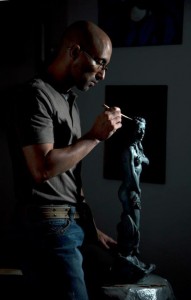Brain Function of Artists
How do I make sense of the things I see? How can I bring an invisible idea into something visible? What about those who turn sounds in their heads into music? How can someone come up with poetry, lyrics for a song, a story, or a dialogue? How can my fingers understand how to shape the clay in a visually logical way according to the design in my brain? How do I make philosophical sense of what I am looking at and articulate the silent language my art is communicating? How can people turn math into art and art into math?

I’ve been reading here and there about the right-brain/left-brain functions. Some say it is a myth. Some say it is not. I was discussing it with my personal physician as well (my wife), who found several articles for me to read. I have no intention to write a research article with fancy references and style (as somebody said I don’t know how to interpret the literature or cite it although I wrote a dissertation) because this blog is not for that. When someone pays me to develop another research study then you would see the whole dissertation format in action. For now I am just expressing my thoughts on these subjects. Nonetheless, it is interesting to see what studies say about the brain function of artists. I don’t argue with these studies unless I make my own study or if they make artists look bad.
According to some the artist’s brain is different in structure and naturally wired to display higher fine motor skills and visual imagery but training and an encouraging environment play an important role as I wrote in The Discipline in The Discipline. It is necessary to cultivate a talent through practice and discipline. This is the combination of nature and nurture. However, while certain areas of the brain are more dominant both sides of the brain are used simultaneously. This is not exclusively for artists since it is said that engaging in creative activities helps improve brain function in multiple areas which I stretch with passion when it comes to cognitive psychology because not only the physical brain changes, the nonphysical brain changes too. To define ‘nonphysical brain’ that is what I call the non-measurable cognitive functions like perception, affect, beliefs, and intuition. Not to mention how engaging in creative activities help relief stress and to connect back to ourselves and it can change lives. it is no secret that art in its many forms also help develop well-rounded individuals.

 What is Cognitive Psychology? Cognitive psychology in simple terms is the science that studies how the mind works. Pretty simple, right? For example, it tries to understand how we memorize things and how to remember. It also tries to understand how we perceive and make sense of information or environmental cues. It helps understand how we develop language skills, how conceptual thinking is developed, and how we make decisions. What we see, hear, touch, taste, feel, and imagine is information. In a sense, cognitive psychology deals with the ‘abstract’ functions of the brain and how it processes the information.
What is Cognitive Psychology? Cognitive psychology in simple terms is the science that studies how the mind works. Pretty simple, right? For example, it tries to understand how we memorize things and how to remember. It also tries to understand how we perceive and make sense of information or environmental cues. It helps understand how we develop language skills, how conceptual thinking is developed, and how we make decisions. What we see, hear, touch, taste, feel, and imagine is information. In a sense, cognitive psychology deals with the ‘abstract’ functions of the brain and how it processes the information.
Guest Post